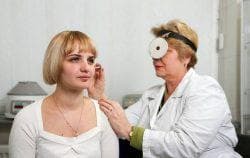
Rumor is one of the most important functions through which a person can receive information about the world around him. In order for his work to take place in full mode, the combined functioning of all parts of the ear is necessary. But today, hearing ailments have become more frequent, among which tubo-otitis deserves special attention. The main symptom of it is severe pain, because of which a person can not fully sleep, rest and work.
Contents
- 1 Description of the disease
- 1.1 Symptoms
- 1.2 Types
- 1.3 Causes of the disease
- 2 Consequences of
Description of the disease

Tubootitis is a catarrhal type of inflammatory process that damages the mucous membrane of the inner ear. Its development occurs because of a violation of the function of the auditory tube. Auditory bones are located in the middle ear directly in the thickness of the temporal bone. In order for their work to proceed fully, it is necessary to fulfill the following condition: the pressure in the middle ear should be equal to the atmospheric pressure.
For this condition to be fulfilled, it is necessary to connect the air cavity with the environment. And this is achieved due to the auditory tube. It opens the "way" to the nasopharynx, because its length in an adult reaches 3.5 cm, and in a newborn - 2 cm.
If the operation of the auditory tube is broken, then a disease such as tubo-otitis is formed. Still it can be called as eustachyte.
What is the difference between tubo-otitis and otitis? For the first disease is characterized by inflammation of the auditory tube and middle ear. But otitis is an inflammatory process that affects any of the ear sections. According to the ICD 10, tubo-otitis has the code H65-H75.
Symptoms of

The main symptom of tubotitis is hearing impairment. In addition, patients experience the following changes:
- obstruction of the ear on the affected side;
- extraneous sound in the ears;
- hearing loss;
- autophony( the ability to hear your voice);
- sensation of movement of water in the ear;
- general symptoms in the form of headache, nausea, general weakness.
During the examination, the doctor notices the retraction of the tympanic membrane inside the cavity, as well as the swelling of the nasal mucosa. The course of the pathological process is carried out smoothly and slowly, with this there is a growing symptomatology characteristic of infectious damage to the ear. The disease at the initial stage is accompanied by a slight obstruction of the ear.
 And if you warm your ear with otitis and how it should be done correctly, it helps to understand this article.
And if you warm your ear with otitis and how it should be done correctly, it helps to understand this article.
What are the most popular drops in children's otitis, is described in detail in this article.
It will also be interesting to know what good drops in the ears are most popular: http: //prolor.ru/u/ lechenie-u / kapli-v-ushi-pri-otite.html
Maybe you will also be interested in learning how to use the drops of Danzilat otitis.
For this reason, not everyone understands that the changes are signs of pathology. If you do not start therapy in time, then the symptomatology will increase, and the inflamed fluid will accumulate in the cavity of the ear drum.
Concentrated liquid - these are excellent conditions for growth and reproduction of harmful microorganisms. If you do not take timely therapeutic measures, then there will be suppuration in the affected area, and this will also initiate the development of an adhesive process between the auditory ossicles.
Thus, even an easy infectious process can cause loss of auditory activity. 
Suppuration of the fluid contributes to the formation of acute purulent otitis media. Its danger is that the membranes and auditory ossicles give in to perforation, and pus can penetrate the brain. The rupture of the membrane can be recognized by the fluid that flows out of the ear. It has a green color.
The reduction of auditory activity with tubo-otitisation is carried out by the type of sensorineural hearing loss. This condition is explained by the prolonged negative pressure in the cavity of the ear drum. It causes irritating effect on the cochlea, as a result of which pathological changes in the auditory nerve fibers are observed.
In small patients, the clinical picture of the inflammatory process manifests itself in the form of increased irritability and crying without a cause. In many children, in addition to infectious diseases of the middle ear, parents notice a fever and a bad night's sleep. Learn more about the symptoms of tubo-otitis in children and what should be the treatment, this information will help.
Types
Depending on the course of the pathological process, it can be acute and chronic. The sharp form can be recognized by the following features: 
- tinnitus, which can be permanent or periodic;
- sensation of poured fluid in the ear;
- temperature values do not deviate from the norm, but there may be exceptions, at which temperature reaches 38 degrees.
For acute tubototitis, relief is typical during yawning or swallowing of saliva.
The chronic form of the pathological process can be recognized by the following symptoms:
- permanent reduction of hearing acuity;
- ringing in the ears and stuffiness;
- clarification of the mucous membrane of the auditory tube.
In addition, tubo-otitis is divided into left-hand and right-sided, taking into account which side was defeated.
Causes of the disease

Various pathogenic bacteria influence the development of tubotitis. Acute inflammatory process develops against the background of inflammation in other ENT organs, when there is a transition of infection to the mucous membrane of the auditory tube. This can happen if the nose is too active, the nasal instruments are not properly used.
Adenoids, polyps and cysts can aggravate the situation. They lead to a permanent finding of infection in the nasopharynx and partial overlapping of the auditory tube. The following factors affecting the development of tubotitis are chronic pathologies of the nasopharynx and sinuses, among which the curvature of the nasopharynx.
Which drops should be used for tubo-otitisation is described in detail in this article.
And here what antibiotics for external otitis in adults is worth using, will help to understand the information from this article.
It will also be interesting to know how the treatment of diffuse external otitis occurs.
What is the treatment for bullous otitis in children and which medications are the most effective, is described in this article.
Consequences of
Complications of tubootitis occur when treatment was not started on time. And this happens for the reason that the disease has a subacute and chronic course with a blurred clinical picture. The role of complications is the phenomenon of stenosis and the formation of scars on the tissues of the auditory tube. In addition, there is a violation of the tympanic membrane. All this contributes to the development of persistent hearing impairments, which can result in irreversible deafness.
The next complication of tubootitis is purulent otitis, which requires complex therapy and carries a particular danger, since it affects the brain.
Tubootit at the first stages of development is very difficult to recognize, because they have a blurred character. Therefore, so often inflammation passes into a chronic form. Cure it completely impossible. In this case it is important to prolong remission and to facilitate the patient as much as possible during exacerbation. So treat your health carefully and with the first uncharacteristic changes you need to visit a doctor.
